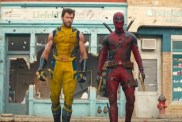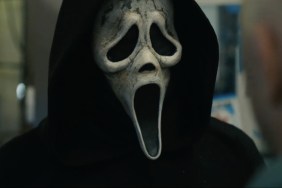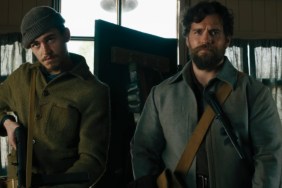
I had never seen Guillermo del Toro‘s Mimic until this past weekend when I watched the new Lionsgate Director’s Cut Blu-ray. The film centers on Susan Tyler (Mira Sorvino), a scientist that genetically engineers a cockroach to kill off disease-carrying cockroaches that are killing New York City children. However, after the experiment proves successful the insects that were engineered to die off have lived on for three years and have grown much larger, some the size of humans.
The film was marred with production issues and ended up grossing just over $25 million on a budget of $28-30 million. It was critically dismissed and now Lionsgate has issued this brand new director’s cut on Blu-ray complete with a brand new introductory prologue and audio commentary from del Toro exploring the pre-production and production turmoil he went through in an attempt to get the film made. And I have to tell you, while the film still plays like an Alien knock-off, this is one of those gems of an audio commentary you can’t get enough of.
After listening to the complete commentary and transcribing over 2,700 of del Toro’s words I have selected the nine most interesting nuggets of information about the film that helped shape not only Mimic, but del Toro ever since.
Del Toro calls it his “imperfect child” and refers to the film as “one of the most important experiences of my life”. Let’s see why…
John Sayles and Steven Soderbergh

After turning in a draft of the screenplay Miramax wanted to give it a rewrite and the first rewrite went to John Sayles (The Howling, Piranha), a draft del Toro calls his “favorite draft of the screenplay” but the studio didn’t like it, after that Steven Soderbergh (Contagion) was up next:
The version John Sayles did is my favorite draft of the screenplay. Needless to say, the screenplay was not as much liked by the studio who further wanted to explain the creatures. I kept saying, “The more we explain them, the more we rob them of their magic.” But explain them we did.
After John Sayles came none other than a very, very nice guy called Steven Soderbergh… He wrote a truly deranged draft that I loved. I called him and said, “This is the best dialogue I’ve ever read. This is fantastic,” but unfortunately it didn’t have a lot to do with the movie we were going to make.
In fact, there’s one thing that remains of the Soderbergh draft, that is the priest being dragged through a small opening in the prologue of the movie.
Matt Greenberg (1408, Halloween: H20, Reign of Fire) also took a stab at the script, but that too was tossed aside.
“America is
not ready fora mixed race couple
in a major motion picture.”

The movie del Toro wanted to make and the movie he ended up making are clearly two different things and it’s a matter of putting all of the pieces together to form the larger picture. The next piece of this puzzle comes in the form of casting decisions based on character traits more than the actors themselves.
The character of Peter, that is played by Jeremy Northam, I originally wanted to be played by Andre Braugher because I thought it would be really important that at the end of the movie we had a Latin kid, Chuy, an American girl, Mira, and an African American central male character as a hero to say mankind survived. Not the Anglo Saxon, Wasp mankind survived.
It was a huge battle, I lost it. Somebody said at some point in the process a horrible line. They said, “America is not ready for a mixed race couple in a major motion picture.” I was absolutely horrified and felt I had been bombed back into medieval times. This was a very jingoistic thing.
He also wanted to make Josh Brolin’s character gay but goes on to say, “You can imagine how long that lived with the studio. It didn’t live beyond one draft, I think, or two.”
“I was condemned to doing
the best giant cockroach
movie ever made.”

For anyone that knows the work of Guillermo del Toro, you know he isn’t about the obvious. It’s part of what makes his films so interesting, they aren’t like anything you’ve seen before and listening to the commentary here you learn of just how detailed and specific he got with this idea of genetically engineered bugs that mutate and are soon able to mimic human form. However, it wasn’t cockroaches del Toro wanted to work with.
Things started deteriorating early on. In the original draft Matthew Robbins and I did we had the creatures being bark beetles, white oak bark beetles, from New York, that nested in Central Park and they were carriers of a bacteria and they needed to be controlled.
I will never forget the day where [executive producer] Michael Phillips (Close Encounters of the Third Kind, Taxi Driver), having removed his loafers in a meeting, proceeded to say, “Well, if it’s New York, what about cockroaches?”
I felt the world had exploded in a wave of horror for me and right then and there I said, “Listen guys, we shouldn’t do that because from now on we’re going to be the giant cockroach movie and there is no way you can go past that absolutely Z-movie conceit. We may be able to show we are a smart movie, but the cockroach, in and of itself, is such a demeaning, fundamentally Z-movie concept to create a movie around we’re never going to outlive that.”
Essentially I lost that argument because somebody at the table was very enthusiastic, New York, cockroaches, that’s a perfect marriage, blah, blah, blah. From then on I was condemned to doing the best giant cockroach movie ever made. That was the biggest achievement I could aspire to on Mimic, but dammit I tried to do it and so did everyone on my team.
Along those lines, del Toro happily relays a story he heard second hand from one of the students of the late Stephen Jay Gould who apparently included a question for an extra point on a final exam asking, “What Hollywood movie got right the reason why insects could grow larger?” Mimic was the right answer.









